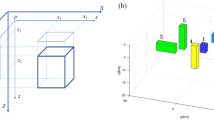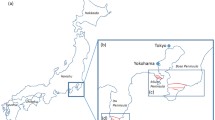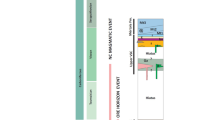Abstract
Imaging shallow subsurface density structure is an important goal in a variety of applications, from hydrogeology to seismic and volcanic hazard assessment. We assess the effectiveness of surface and subsurface gravity measurements in estimating the density structure of a well-characterized rock volume: the mesa (a small, flat-topped plateau) upon which the town of Los Alamos, New Mexico, USA is located. Our gravity measurements were made on the mesa surface above a horizontal tunnel and underground, within the tunnel. We demonstrate that, in the absence of other geophysical data such as seismic data or muon attenuation, subsurface (tunnel) gravity measurements are critical to accurately recovering geologic structure. Without the tunnel data, our resolution is limited to roughly the surface gravity station spacing, but by including the tunnel data we can resolve structure to a depth of ~ 10 times the surface gravity station spacing. Densities were obtained using both forward modeling and a Bayesian inverse modeling approach, incorporating relevant constraints from geologic observations. We find that Bayesian inversion, with geologically relevant prior, is a superior approach to the forward models in terms of both robustness and efficiency and correctly predicts the orientation and elevation of important geologic features.








Similar content being viewed by others
References
Bagnardi, M., Poland, M. P., Carbone, D., Baker, S., Battaglia, M., & Amelung, F. (2014). Gravity changes and deformation at Kīlauea Volcano, Hawaii, associated with summit eruptive activity, 2009–2012. Journal of Geophysical Research, 119, 7288–7305. https://doi.org/10.1002/2014JB011506.
Bertete-Aguirre, H., Cherkaev, E., & Oristaglio, M. (2002). Non-smooth gravity problem with total variation penalization functional. Geophysical Journal International, 149, 499–507.
Broxton, D. E., & Vaniman, D. T. (2005). Geologic framework of a groundwater system on the margin of a rift basin, Pajarito Plateau, North-Central New Mexico. Vadose Zone Journal, 4, 522–550. https://doi.org/10.2136/vzj2004.0073.
Chapin, C. E., & Cather, S. M. (1994) Tectonic setting of the axial basins of the northern and central Rio Grande rift. In G. R. Keller & S. M. Cather (Eds.), Basins of the Rio Grande rift: Structure, stratigraphy, and tectonic setting: Geological Society of America (pp. 5–25), Special Paper 291.
Cogbill, A.H., J.F. Ferguson, Keating, E.H., & Chen, M. (2006). Use of absolute gravity measurements to monitor groundwater in the Española Basin, New Mexico. In Symposium on the application of geophysics to engineering and environmental Problems (pp. 755–766). https://doi.org/10.4133/1.2923716
Daggett, P. H., Keller, G. R., Morgan, P., & Wen, C. (1986). Structure of the southern Rio Grande Rift from gravity interpretation. Journal of Geophysical Research, 91(B6), 6157–6167.
Gardner J. N., et al. (1999). Structural geology of the Northwestern Portion of Los Alamos National Laboratory, Rio Grande Rift, New Mexico: Implications for Seismic Surface Rupture Potential from TA-3 to TA-55, Los Alamos National Laboratory Report LA-13589-MS.
Gardner, J.N., & Goff, F. (1984). Potassium-argon dates from the Jemez volcanic field: Implications for tectonic activity in the north-central Rio Grande rift. In New Mexico Geol. Soc. Guidebook, 35th field conference, Rio Grande rift, Northern New Mexico (pp. 75–81). Albuquerque: University of New Mexico.
Guardincerri, E., Rowe, C., Schultz-Fellenz, E., Roy, M., George, N., Morris, C., et al. (2017). 3D cosmic ray muon tomography from an underground tunnel. Pure and Applied Geophysics, 174(5), 2133–2141. https://doi.org/10.1007/s00024-017-1526-x.
Hammer, S. (1950). Density determination by underground gravity measurements. Geophysics, 15, 637–652. https://doi.org/10.1190/1.1437625.
House, M., Kelley, S., & Roy, M. (2003). Refining the footwall cooling history of a rift flank uplift, Rio Grande rift, New Mexico. Tectonics. https://doi.org/10.1029/2002TC001418.
Jachens, R. C., & Eaton, G. P. (1980). Geophysical observations of Kilauea Volcano, Hawaii, 1. Temporal gravity variations related to the 29 November, 1975, M = 7.2 earthquake and associated summit collapse. Journal of Volcanology and Geothermal Research, 7, 225–240.
Jacob, T., Bayer, R., Chery, J., & Le Moigne, N. (2010). Time-lapse microgravity surveys reveal water storage heterogeneity of a karst aquifer. Journal of Geophysical Research, 115, B06402. https://doi.org/10.1029/2009JB006616.
Jourde K., Gibert, D., & Marteau, J. (2014). Joint inversion of muon tomography and gravimetry resolving kernel approach. arXiv:1411.5146v1 [physics.geo-ph]
Kazama, T., Okubo, S., Sugano, T., Matsumoto, S., Sun, W., Tanaka, Y., et al. (2015). Absolute gravity change associated with magma mass movement in the conduit of Asama Volcano (Central Japan), revealed by physical modeling of hydrological gravity disturbances. Journal of Geophysical Research: Solid Earth, 120, 1263–1287. https://doi.org/10.1002/2014JB011563.
Kennedy, J., Ferre, T. P. A., & Creutzfeldt, B. (2016). Time-lapse gravity data for monitoring and modeling artificial recharge through a thick unsaturated zone. Water Resources, 52, 7244–7261. https://doi.org/10.1002/2016WR018770.
Krahenbuhl, R. A., & Li, Y. (2012). Time-lapse gravity: A numerical demonstration using robust inversion and joint interpretation of 4D surface and borehole data. Geophysics, 77(2), G33–G43.
LaFehr, T. R. (1983). Rock density from borehole gravity surveys. Geophysics, 48(3), 341–356.
Lewis, C. J., Gardner, J. N., Schultz-Fellenz, E. S., Lavine, A., Reneau, S. L., & Olig, S. (2009). Fault interaction and along-strike variation in throw in the Pajarito fault system, Rio Grande Rift, New Mexico. Geosphere, 5, 252–269.
McGehee, E., Garcia, C. L. M., Loomis, E., Towery, K., Ronquillo J., & Isaacson, J. (2004). Historical context of W. Site, technical area 41 (Vol. 1). Historic Building Report No. 231. Los Alamos National Laboratory Report LA-UR-04-6492.
Nagy, D., Papp, G., & Benedek, J. (2000). The gravitational potential and its derivatives for the prism. Journal of Geodesy, 74, 552–560.
Nishiyama, R., Tanaka, Y., Okubo, S., Oshima, H., Tanaka, H. K. M., & Maekawa, T. (2014). Integrated processing of muon radiography and gravity anomaly data toward the realization of high-resolution 3-D density structural analysis of volcanoes: Case study of Showa-Shinzan lava dome, Usu, Japan. Journal of Geophysical Research: Solid Earth, 119, 699–710. https://doi.org/10.1002/2013JB010234.
Poland, M. P., & Carbone, D. (2016). Insights into shallow magmatic processes at Kilauea Volcano, Hawai’I from multi-year, continuous gravity time series. Journal of Geophysical Research, 121, 5477–5492. https://doi.org/10.1002/2016JB013057.
Roecker, S., Thurber, C., & McPhee, D. (2004). Joint inversion of gravity and arrival time data from Parkfield: New constraints on structure and hypocenter locations near the SAFOD drill site. Geophysical Research Letters. https://doi.org/10.1029/2003GL019396.
Roy, M., Kelley, S., Pazzaglia, F. J., Cather, S., & House, M. (2004). Middle Tertiary buoyancy modification and its relationship to rock exhumation, cooling, and subsequent extension at the eastern margin of the Colorado Plateau. Geology, 32(10), 925–928. https://doi.org/10.1130/G20561.1.
Roy, M., MacCarthy, J. K., & Selverstone, J. (2005). Upper mantle structure beneath the eastern Colorado Plateau and Rio Grande rift revealed by Bouguer gravity, seismic velocities, and xenolith data. Geochemistry, Geophysics, Geosystems. https://doi.org/10.1029/2005GC001008.
Saltus, R. W., & Blakely, R. J. (2011). Unique geologic insights from “non-unique” gravity and magnetic interpretation. GSA Today, 21(12), 4–11. https://doi.org/10.1130/G136A.1.
Tarantola, A. (2005). Inverse problem theory and methods for model parameter estimation, SIAM. ISBN 978-0-89871-572-9.
Tarantola, A., & Valette, B. (1982). Inverse problems = Quest for information. Journal of Geophysics, 50, 159–170.
Van Camp, M., & Vauterin, P. (2005). Tsoft: graphical and interactive software for the analysis of time series and Earth tides. Computers & Geosciences, 31, 631–640.
Witter, J. B., Siler, D., Faulds, J. E., & Hinz, N. H. (2016). 3D geophysical inversion modeling of gravity data to test the 3D geologic model of the Bradys geothermal area, Nevada, USA. Geothermal Energy, 4(1), 14. https://doi.org/10.1186/s40517-016-0056-6.
Acknowledgements
We thank the following individuals who contributed to this project: M. Dichter, A. Bonneville, G. Meyer, D. Broxton, J. Ferguson, R. Kelley, E. Schultz-Fellenz, and A. Cogbill for geologic discussions, loaning us equipment, and assistance with fieldwork. This work was supported through a contract from the Los Alamos National Laboratory Center for Space and Earth Sciences (CSES) and through the United States Department of Energy Subsurface Science and Technology, Research and Energy Development (SubTER) program. The manuscript benefited from helpful and thorough reviews from two anonymous referees. This is Los Alamos National Laboratory Publication number LA-UR-17-26322. M. R. also acknowledges support from a fellowship at the Aspen Center for Physics, during the writing of this manuscript.
Author information
Authors and Affiliations
Corresponding author
Appendix
Appendix
Model discretization Our forward calculations utilize a very high-resolution model with 1.6 × 105 rectangular prisms (each with area ~ 42 m2 in the x–y plane and vertical height = elevation above the minimum elevation of 2089 m) over a region that is 1402.1 m (E–W) by 1909.5 m (N–S). We find that the model results are unchanged if a lower resolution discretization is used (~ 15–25 m horizontal linear dimension of prisms) but the predicted gravity at each station is quite sensitive to the lateral dimensions of the region considered.
For our inverse models, we discretize the terrain into cubical voxels (cells), but limited our calculations to a maximum of 104 voxels to avoid inversion issues for large matrices in Matlab (in our formulation, the only matrix inverse we need to calculate is the inverse of the model covariance matrix, \(C_{\text{m}}^{ - 1}\)). We do not, however, wish to compromise on the accuracy of the forward-predicted gravity. To understand how best to decimate the LIDAR data (5 points/m2) and optimize the terrain specification for inversion, we explored a range of voxel dimensions and dimensions of the discretized region. Our optimized configuration produces the same predicted gravity at each station as our high-resolution forward calculations, but uses high resolution (163 m3) in the region containing the stations and lower resolution (200 × 16 × 16 or 200 × 200 × 16 m3) at the edges (Fig. 9).
Map view (a) and perspective view (b) of our optimized discretization used in the inverse models, where lower left voxel corner locations are indicated (black dots) in relation to station locations (red dots). The dashed red rectangle in (a) indicates the high-resolution part of the model, as depicted in Fig. 8
Resolution tests for the 3D inverse models with “true” density structure given by a N–S and E–W sinusoidal variation (a–c), with wavelength as indicated (double arrows in a–c). Lower panels show the corresponding recovered density structure for each synthetic (d, e). Each column corresponds to varying spatial wavelength in the true structure but the (isotropic) spatial correlation length, λ, to smooth the model is fixed for all tests. The tests here are designed to illustrate the limitations given our station geometry (white dots = station locations)
Inverse model resolution test and prior We test the ability of the model to resolve lateral variations in density by prescribing a 2D sinusoidally varying density structure: \(\rho \left( {x,y} \right) = \rho_{0} \left\{ {1 + A\left[ {sin\left( {\frac{2\pi x}{w}} \right) + sin\left( {\frac{2\pi y}{w}} \right)} \right]} \right\}\), with \(\rho_{0}\) = 1400–2100 kg/m3, A = 0.1–0.5, w = 70–700 m.
Using the discretization above, we prescribe the layered prior with a three-layered density identical to the geologically relevant model used in our forward calculation: ρ 3 = 1850 kg/m3 (uppermost layer, Qbt3); ρ 2 = 2100 kg/m3 (middle layer, Qbt2); ρ 1 = 1420 kg/m3 (lowest layer, Qbt1). The prescribed starting elevations of the (initially flat, planar) layer interfaces were: 2180–2200 m for the Qbt3-2 (upper) contact and 2090–2150 m for the Qbt2-1 (lower) contact; our results are insensitive to the starting layer elevations.
Rights and permissions
About this article
Cite this article
Roy, M., Lewis, M., Johnson, A. et al. Inferring Shallow Subsurface Density Structure from Surface and Underground Gravity Measurements: Calibrating Models for Relatively Undeformed Volcanic Strata at the Jemez Volcanic Field, New Mexico, USA. Pure Appl. Geophys. 175, 1003–1018 (2018). https://doi.org/10.1007/s00024-017-1742-4
Received:
Revised:
Accepted:
Published:
Issue Date:
DOI: https://doi.org/10.1007/s00024-017-1742-4






